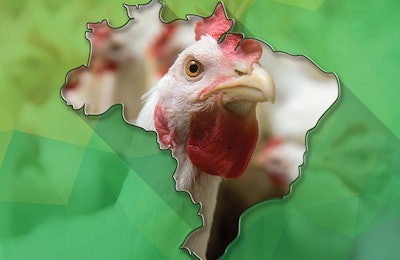
The leaders of Brazil’s largest poultry companies are focused on solidifying the country’s role as a leading exporter of chicken to the rest of the world, according to a recent panel discussion.
As part of the 2019 SIAVS International Poultry and Pork Show in São Paulo, leaders of three major companies: Cooperativa Central Aurora Alimentos, BRF S.A. and JBS S.A. spoke about the state of Brazil’s poultry industry and its larger role in the world. The panel took place on August 28.
The panelists were:
- Mário Lanznaster, president of Cooperativa Central Aurora Alimentos
- Lorival Luz, CEO of BRF S.A.
- Gilberto Tomazoni, CEO of JBS S.A.
Integration in Brazil
Lanznaster explained what integrated poultry production looks like in Brazil. In essence, it is a contractual relationship between the grower and integrator, with clear rules regarding the reciprocal obligations and guarantees of both parties for the delivery and reception of the produced goods.
Today, Aurora prepares detailed reports on integrated production which includes data on factors such as feed consumption, feed conversion and mortality to create a score upon which payment is based.
“It’s a very good system, because there are no arguments,” Lanznaster said. “This way, the grower takes many precautions to avoid deviating from the objective.”

Mário Lanznaster, Aurora Alimentos (Courtesy ABPA)
The growers receive day-old chicks and grow them for 42 days. The integrator supplies the chicks and the feed. Lanznaster said the integrator is charged providing with technical assistance for animal health, feeding, facility management, operational planning and genetics. The grower provides the poultry houses and labor and must follow the recommendations provided by the integrator’s technical staff exactly.
According to WATT Global Media’s data on the world’s top poultry companies, Aurora processed 264 million broilers in 2018. It is ranked as the 34th largest broiler company in the world in terms of millions of head slaughtered annually.
Brazil’s export markets
Luz spoke about Brazil’s role in the global protein market. Globally, Brazil is responsible for about 15% of overall chicken production. BRF, which processed 1.628 billion broilers in 2018, is ranked as the third-largest broiler producer in the world by WATT Global Media. Luz said if BRF was a country, it would be the world’s seventh-largest poultry producing nation.
Since 1990, there’s been 2.1% annual growth in animal proteins. During this same period, chicken grew at 3.8% annually. Global population growth comes mainly from emerging economies, where lower cost protein is generally in demand. This is where chicken comes in.
In the same period, exports have grown at a higher rate than consumption and above the historic average of 4%. But, chicken is growing at 6%. Brazil is a net exporter of chicken because its exports exceed its domestic consumption.
Luz said Brazil has an excellent export opportunity because of its favorable climatic conditions, supply of natural resources and its integrated production system. The country is trying to position itself for export growth, but this ambition puts pressure on the country’s producers to do it right.
“It is our image and our credibility that will make us achieve those (export) opportunities,” Luz said.

Lorival Luz, BRF (Photo by Benjamín Ruiz)
Brazil is particularly relevant in certain sectors. For example, 72% of the world’s halal chicken is produced in Brazil. About half of all the chicken wings imported by China and Hong Kong come from Brazil. Luz said working with these markets makes the Brazilian producers responsible for meeting the strict regulations and requirements established by these markets. Any product deviation can ruin the market for everyone.
Luz said it’s important the country’s producers maintain an open door – and its politicians maintain good diplomatic relationships – in order for the export scenario to be expanded.
One trend that can re-define the global protein market is the current situation with African swine fever (ASF) in China. The country is the biggest protein consumer, so the ASF scenario represents another opportunity for exports. However, the decline in production and inventory in China is so sharp that even the combined production of Brazil and the U.S. can’t replace the losses. This structural breakdown will extend for months or years.
Luz said businesses should be cautious not to invest too much right now. When China recovers, he said, it will replace family and backyard swine rearing with professional farming. He said China was already modernizing its pork industry and the ASF crisis will only accelerate the transition.
The world’s largest protein company
Tomazoni spoke about how the world is in a special moment for animal protein. JBS, which processed 3.5 billion broilers in 2018, is ranked as the world’s largest broiler company by WATT Global Media.
JBS’ exports are worth about $3.3 billion and account for about 25% of the company’s total sales. The company, which recently restructured, sells 51% of its product in the U.S., 16% in Asia, 13% in Brazil, 6% in Europe, 4% in Mexico, 4% in Africa, 4% in Oceania, 3% in Canada, 1% in South America and 1% in Russia.
With a business supplying five different types of animal protein to several geographic areas, the company follows a financial strategy of risk mitigation, stabilization and consistency of bottom line. JBS was on an accelerated growth track – doubling in size every three years – until 2014. Today, growth is slower. The company’s strategy now is to reduce debts, generate cash flow and prepare the company for the future.
Currently, overall consumption of animal proteins is growing. However, chicken and pork will be the ones that grow the most by 2050. However, the presence of ASF on the global market is making JBS seriously assess its ability to meet a heightened global demand, Tomazoni said.

Gilberto Tomazoni, JBS (Photo courtesy ABPA)
Nevertheless, he said the market is favorable for proteins and noted that integration is essential for Brazil to meet growing demand and continue to grow. Specifically for JBS, an increase in global demand for protein comes at a good time.
Going forward, JBS is forecasting its greatest growth sector will be its added value, branded products. It will focus on adding value to its total product suite, too. Additionally, the company will focus on building trust and increasing its transparency along with working on technological innovations that will help modernize its global supply chain.


















